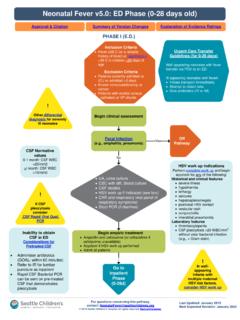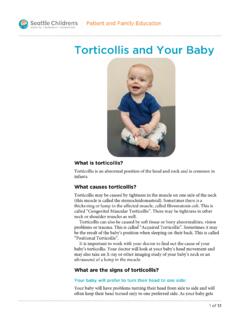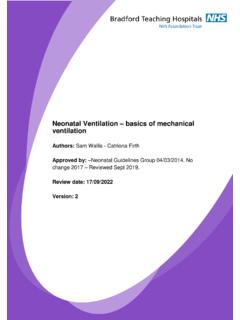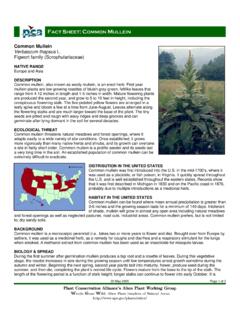Transcription of Neonatal Nursing Education Brief: Bubble CPAP - …
1 Neonatal Nursing Education brief : Bubble CPAP - Continuous Positive Airway Pressure Bubble CPAP is a gentle, non- invasive form of respiratory support. It has been shown to be safe and effective. When used immediately after birth, it can help avoid intubation and mechanical ventilation. There are several benefits of Bubble CPAP, including the production of wave like oscillations that can mitigate surfactant deficiency and respiratory distress syndrome. NICU, CPAP, Bubble CPAP, continuous positive airway pressure, RDS Bubble CPAP - Continuous Positive Airway Pressure Purpose and Goal: CNEP # 2117 Learn about CPAP use in the NICU Learn about the benefits of Bubble CPAP use in preterm infants None of the planners, faculty or content specialists has any conflict of interest or will be presenting any off-label product use.
2 This presentation has no commercial support or sponsorship, nor is it co-sponsored. Requirements for successful completion: Successfully complete the post-test Complete the evaluation form Date November 2019 November 2021 Learning Objectives Describe the risks of surfactant deficiency in the neonate Describe the advantages of using Bubble CPAP in the NICU Describe 2 strategies to avoid nasal trauma from CPAP Introduction Nasal CPAP is commonly used in the NICU CPAP is a mode of mechanical ventilation It can minimize Neonatal lung injury While promoting physiologic stability CPAP works by delivering continuous Air and oxygen Distending pressures It is increasingly used for respiratory support CPAP stents open the airways And reduces work of breathing Development of the
3 Respiratory System Fetal lung development is divided into 5 stages The embryonic stage 0 - 7 weeks gestation The pseudoglandular stage 7 - 17 weeks gestation The canalicular stage 17 - 27 weeks gestation The saccular stage 28 - 36 weeks gestation The alveolar stage 36 weeks gestation - 2 years The embryonic stage is characterized by: Formation of the trachea Development of mainstem bronchi Development of pulmonary arteries The pseudoglandular stage is characterized by: Differentiation of airways Into conducting bronchioles Into terminal bronchioles Proliferation of pulmonary vasculature The canalicular stage is characterized by: Formation of distal airways Secretion of surfactant into alveoli At 24 weeks gestation The saccular stage is characterized by: Increasing surface area for gas exchange Formation of capillary air-blood interface The alveolar stage is characterized by.
4 Formation of alveoli Maturation of alveoli Multiplication of alveoli Functional immaturity of the lungs Is dependent on gestational age at birth Because surfactant production Is often not initiated And generally not mature enough To support extrauterine life Without mechanical support Until 32-36 weeks gestation Surfactant is a mixture of several substances Protein Phopho-lipids Neutral lipids Surfactant lowers the surface tension At the air-liquid alveoli interface And prevents alveolar collapse Therefore, infants <32 weeks gestation Have the highest risk of surfactant deficiency Have the highest risk of respiratory distress Have the highest risk of developing co-morbidities BPD ROP IVH Transition to Extrauterine Life Transition from fetal to Neonatal life Is a complex process That involves physiologic changes Most term infants have a smooth transition Most premature infants are at a disadvantage Premature infants <32 weeks gestation Are generally unprepared to handle The physiologic demands of extrauterine life Alveolar instability and collapse are common Instability and collapse can cause Impaired oxygenation Decreased functional residual capacity
5 Hypoxemia Respiratory distress Globally, over 13 million preterm infants <37 weeks gestation Are born each year In the USA, preterm birth rates remain high Over 400,000 infants Are born <37 weeks every year Preterm infant mortality and morbidity Are directly proportional To gestational age at birth Efforts to reduce mortality and morbidity Begin immediately after birth And start with respiratory support Supportive respiratory measures are indicated To support immature lungs To establish physiologic stability Supportive measures may include CPAP Endotracheal intubation mechanical ventilation CPAP is a mode of ventilation that is Gentle Non- invasive Well studied It can help mitigate the effects of lung immaturity By minimizing lung injury And improving long-term outcomes Continuous Positive Airway Pressure
6 Historically, mechanical ventilation Was used to oxygenate and ventilate infants Over time, it was discovered that ventilation Caused volutrauma in infants Caused barotrauma in infants Increased morbidity and mortality Respiratory support strategies shifted From invasive strategies To non- invasive strategies CPAP was first recognized in 1971 An initial CPAP trial met with success Administered via endotracheal tube Outcome: 16 out of 20 infants survived CPAP is a form of continuous distending pressure There are two main types of CPAP in use: Continuous Flow Conventional CPAP Bubble CPAP Variable Flow Infant Flow Driven Nasal-Jet Driven Continuous Flow CPAP The flow of gas is fixed The flow of gas is constant In Conventional CPAP Gas flows into the circuit And into an exhalation valve Which opens alternatively To a set ventilator pressure In Bubble CPAP Gas flows into the circuit And into a submerged expiratory limb To a set water pressure Variable Flow CPAP The flow of gas is inconsistent In Infant Flow Driven CPAP An infant flow driver Adjusts to the gas flow During the respiratory cycle While the gas flow is altered The set pressure is constant In Nasal-Jet CPAP The
7 System tubing Is attached to a generator That adjusts the gas flow Based on sensed pressure Based on airway resistance Multiple benefits of Bubble CPAP have been shown Bubble Continuous Positive Airway Pressure Bubble CPAP was first introduced in 1975 Bubble CPAP is a gas flow mixture That is warmed and humidified And flows from a wall to the infant It is administered via mask or nasal prongs The expiratory limb of the system Is submerged in a sterile water chamber At the desired depth in centimeters That produces positive end expiratory pressure The oxygen flow rate ranges from 5-10 L/minute And adjusted until gaseous bubbling is seen The higher the flow the more bubbling The higher the flow the higher the pressure The gas flow rate is an important variable Fixed CPAP flow rates Provide more effective pressures The bubbling provides a unique oscillation Via the submersion in sterile water Of the expiratory limb of the system The oscillations have been found to: Produce vibrations That simulate waveforms That improve gas exchange That improve CO2 elimination That work via facilitated diffusion The oscillations are an important feature That distinguish Bubble CPAP From other forms of CPAP Multiple Bubble CPAP studies have shown.
8 Lower oxygen requirements Minimal respiratory decompensation Less need for mechanical ventilation Fewer infants with chronic lung disease And decreased length of NICU stays Bubble CPAP has also been shown to: Be non- invasive Be inexpensive Be easy to use Several comparison studies have been done That show improved outcomes Using continuous Bubble CPAP Versus mechanical ventilation In comparison to other forms of respiratory support Bubble CPAP has been shown to: Reduce alveolar structural damage Reduce pulmonary edema Reduce pulmonary inflammation Reduce pulmonary fibrosis These benefits are achieved by the oscillation Over time, Bubble CPAP results in: Higher fluctuations of pressure Higher fluctuations of frequency Higher recruitment of atelectasis Equitable distribution of gas transport Of note.
9 The noise from Bubble CPAP Has been shown to surfactant production Physiological Effects of Bubble CPAP CPAP works on the continuous flow principle CPAP uses blended air and oxygen That is heated and humidified Then delivered via low resistance Via nasal masks and nasal prongs The distal end of the expiratory tubing Is submerged underwater The delivered pressure Equals the depth of submersion Varying the depth of the submersion Changes the pressure delivered Bubbling and pressure will cease whenever The interface is blocked The interface is displaced The infant stops breathing There are currently no alarms available Frequent intermittent checks are mandatory Bubble CPAP pressures depend on The infant breathing through The submerged expiratory tubing If the infant s mouth is open Flow can leak Causing a drop in pressure The physiologic effects of CPAP include.
10 Decreased upper airway occlusion Decreased upper airway resistance Increased diaphragmatic tone Increased diaphragmatic contractility Increased lung compliance Decreased lower airway resistance Increased tidal volume in stiff lungs Improved ventilation and perfusion Decreased oxygen requirement Conservation of alveolar surfactant Decreased pulmonary edema Bubble CPAP may prevent the need for intubation When used immediately at birth In late preterm and tern infants And when used continuously in preterm infants Until 32 weeks gestational age Respiratory Support of Preterm Infants mechanical ventilation is important In the care of infants With respiratory failure The goals of respiratory support are: To maintain adequate gas exchange To minimize the risks of lung injury There is a significant association between Prolonged respiratory support And bronchopulmonary dysplasia And poor neurodevelopmental outcomes Providing Bubble CPAP at birth can help It is an effective non- invasive alternative option In addition to intubation As an alternative to intubation Many studies have shown improved oxygenation It is an excellent option for post-extubation care It provides critical support For in and out surfactant For early elective extubation Benefits of CPAP for Premature Infants The exact












